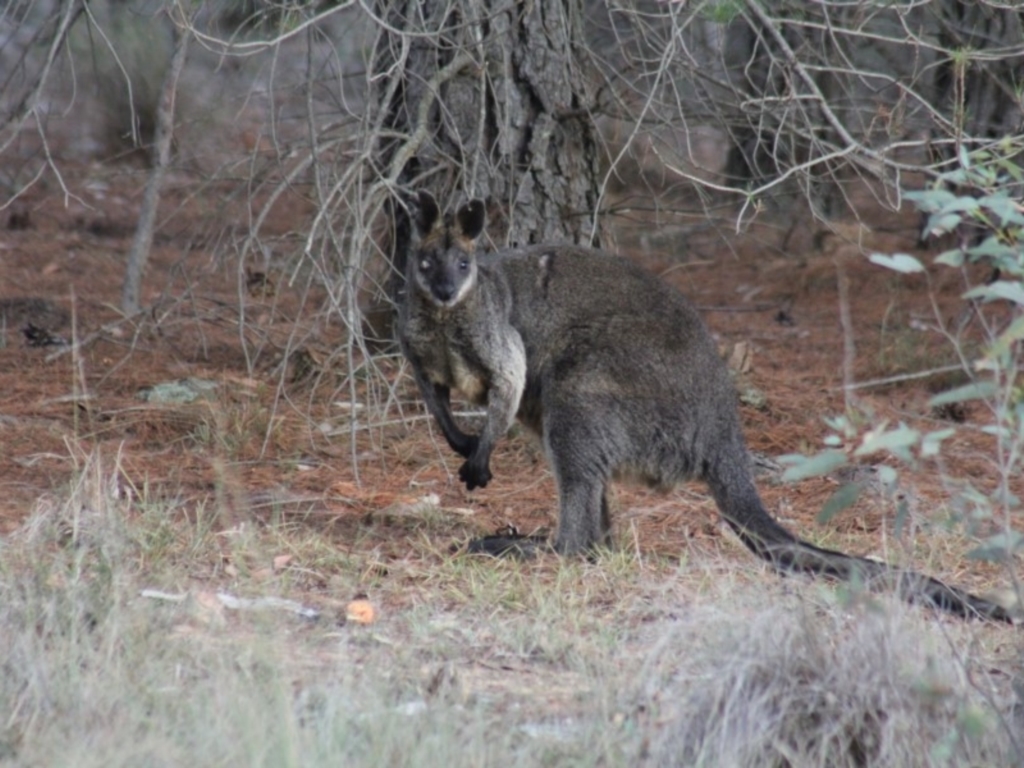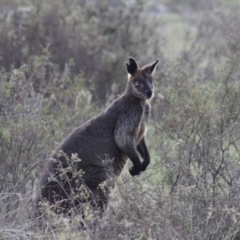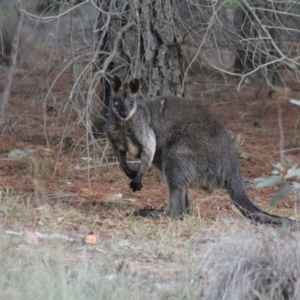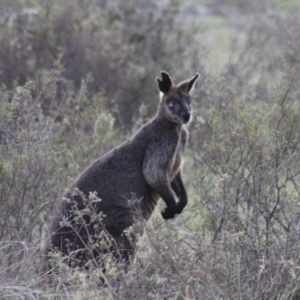Swamp Wallaby at Gundaroo, NSW
Identification history
| Wallabia bicolor | 11 Jun 2019 | ChrisM | ||
| Wallabia bicolor | 10 Jun 2019 | Gunyijan |
Identify this sighting
Please Login or Register to identify this sighting.
User's notes
Female wallaby visiting from nearby property
11 comments
MichaelMulvaney
wrote:
12 Jun 2019
This is the second Swamp Wallaby sighting in recent weeks of a wallaby totally blind or blind in one eye. The blindness may be caused by infection by the parasite Toxoplasma gondii, of which cats are the main primary hosts. The parasite can cause eye diseases leading to lesions and in some cases blindness in a range ofmammals, I am interested in any further examples of blindness in native mammals - particularly Swamp Wallabies - I am wondering whether they are particularly susceptible.
DonFletcher
wrote:
12 Jun 2019
Blindness in macropods and other mammals is ubiquitous and under reported. I have seen a massive increase in reporting that was due only to something drawing attention to the phenomenon. So it is not going to be easy to get an impression of reality by asking for reports. Pathology and ecology are necessary to distinguish between a new epidemic and the normal background rates of conditions such as cataracts. For example frequency of blindness due to cataracts would be expected to be higher in unculled populations that are not heavily affected by motor vehicle collisions and other forms of 'predation'. That is because those populations contain a higher proportion of old individuals.
michaelb
wrote:
12 Jun 2019
Hi Michael M
See sighting 3343648, another half blind Swamp Wallaby at Pine Island:
 Wallabia bicolor (Swamp Wallaby) on 13 Jan 2016
Wallabia bicolor (Swamp Wallaby) on 13 Jan 2016
See sighting 3343648, another half blind Swamp Wallaby at Pine Island:
MichaelMulvaney
wrote:
14 Jun 2019
Thanks Don - we don't seem to get sightings of Blind eastern greys or red necks - are swamp wallabies more prone to it? are they longer lived?
Mike
wrote:
14 Jun 2019
michaelb
wrote:
14 Jun 2019
I've seen Swamp Wallabies with blind eyes several times, but no other macropods.
DonFletcher
wrote:
14 Jun 2019
Michael, I see more swampies with cataracts too (but maybe I'm getting closer to them than to RNWs, EGKs or Wallaroos). What I was alluding to was the effect of observer awareness on reporting rate. Years ago there was local publicity about a virus spreading in kangaroos that causes blindness. The publicity did not say so but the virus only occurred out west. However over the next few weeks PCS got lots of reports of blind eastern greys, especially through urban wildlife, and for a while the reports were being fed to me. I think there was probably no increase locally in blindness but the reporting of it could have convinced you otherwise. It goes the other way too - from capture darting kangaroos (which requires a close approach) I realise there is an incidence of cataracts that you tend not to appreciate until you are closely examining the unconscious animal.
DonFletcher
wrote:
14 Jun 2019
Toxoplasmosis causes blindness and is an interesting possibility if Swamp Wallabies are more exposed to infection from cat droppings. (SW do seem to eat a wider range of material than other common local macropods, including animal tissue. Maybe that extends to eating or sniffing cat droppings.) There is good information available from Wildlife Health Australia, including the sampling required to test for toxo, either blood serum (from live animals) or frozen fresh tissue.
DonFletcher
wrote:
14 Jun 2019
Also, I almost forgot, hand reared macropods develop cataracts late in life if they are fed lactose (eg in cows milk) at an early age. There is no legal rearing of EGKs in Canberra, so carers more often release SW. Some of the older hand-reared wallabies may have been reared decades ago before training of wildlife carers became common.
Shell.S.
wrote:
14 Jun 2019
Morning All
I witnessed a fully blind Swamp Wallaby at Swamp Creek recreation area approximately three years ago. The individual was male and aged. There was (is?) a high number of feral cats at that location. Sadly the individual was deliberately run over.
I worked in a NZ zoo where the entire captive population of Macropus rufogriseus (Red-necked Wallabies) died of Toxoplasma gondii after first going blind from the parasite. This was attributed to feral cats at the location. Captive Red-necks appear to be common sufferers in the articles I've read on incidence of Toxoplasmosis in Macropods internationally. Other Macropods are also reported to suffer from the condition. However, perhaps there are less captive Swamp Wallabies to compare to. I have not witnessed any blind Red-necks locally.
Re. Wildlife in our region, I recall there being a young blind Eastern Grey Kangaroo at Ingledene within the last five years, however it was albino and the condition more possibly related to that.
Don, I agree with your comments on the frequency of the condition being potentially more prevalent in species that live longer due to a comparative lack of 'predation'; however I would think Red-necks are included in that category. And Macropus robustus (Common Wallaroo).
I jumped to the idea of Toxoplasmosis due to my zoo experience and subsequent readings on captive Macropods, but other potential causes of blindness in wild Macropods, particularly wallabies? There is lots on the internet on viral-related blindness in Eastern Greys, but not other species.
I witnessed a fully blind Swamp Wallaby at Swamp Creek recreation area approximately three years ago. The individual was male and aged. There was (is?) a high number of feral cats at that location. Sadly the individual was deliberately run over.
I worked in a NZ zoo where the entire captive population of Macropus rufogriseus (Red-necked Wallabies) died of Toxoplasma gondii after first going blind from the parasite. This was attributed to feral cats at the location. Captive Red-necks appear to be common sufferers in the articles I've read on incidence of Toxoplasmosis in Macropods internationally. Other Macropods are also reported to suffer from the condition. However, perhaps there are less captive Swamp Wallabies to compare to. I have not witnessed any blind Red-necks locally.
Re. Wildlife in our region, I recall there being a young blind Eastern Grey Kangaroo at Ingledene within the last five years, however it was albino and the condition more possibly related to that.
Don, I agree with your comments on the frequency of the condition being potentially more prevalent in species that live longer due to a comparative lack of 'predation'; however I would think Red-necks are included in that category. And Macropus robustus (Common Wallaroo).
I jumped to the idea of Toxoplasmosis due to my zoo experience and subsequent readings on captive Macropods, but other potential causes of blindness in wild Macropods, particularly wallabies? There is lots on the internet on viral-related blindness in Eastern Greys, but not other species.
CathB
wrote:
14 Jun 2019
I reported two eastern greys with diseased/injured eyes last year (sighting 3871218 and author's notes). The eyes were protruding and looked different from the cloudiness seen above.
Please Login or Register to comment.
Nearby sightings
Location information
- Coordinates 149.220447-35.034431
- Places Gundaroo, NSW
Sighting information
- 1 Abundance
- 2 Jan 2019 07:19 PM Recorded on
- Gunyijan Recorded by
Additional information
- Male Gender
- Breeding behaviour Breeding behaviour
Species information
- Wallabia bicolor Scientific name
- Swamp Wallaby Common name
- Not Sensitive
- Local native
- Non-Invasive
- Up to 1338.8m Recorded at altitude
- 353 images trained Machine learning
Record quality
- Images or audio
- More than one media file
- Confirmed by an expert moderator
- Nearby sighting(s) of same species
- GPS evidence of location
- Description
- Additional attributes



















































